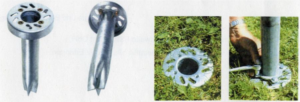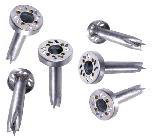This important decision by the German Federal Supreme Court of 15 January 2017 is about how the protection against copying under unfair competition law interplays with trademark and patent law:
The plaintiff manufactures and sells anchor bolts which are used to mount traffic signs:
The defendant offers the following bolts:
Until 2006, the plaintiff’s bolt was protected by a patent (EP0243376 – device for anchoring bar-shaped objects, in particular poles in the soil). Furthermore, the shape of the bolt was subject to a Union Mark registered in 2007 (No. 004655163). In 2013, following the defendant’s application, EUIPO cancelled that registration on the basis of Art. 7 I e ii of the Trademark Regulation (sign which consists exclusively of a shape necessary to obtain a technical result).
The plaintiff alleges that offering the defendant’s bolts violates Sec. 4 No. 3 a) of the German Act against Unfair Competition (UWG). According to that provision, offering a product which is an imitation of a competitor’s product is unfair if (i) the original product has distinctive features which can serve as an indication of source to the public (so-called competitive distinctiveness) and (ii) if there is a risk of or actual confusion regarding the commercial source of the imitation. Broadly speaking, Sec. 4 No. 3a) UWG corresponds to the tort of passing-off.
The action was turned down in the first two instances, mainly because the copied features were part of the patent claim. The Federal Supreme Court has remitted the matter back to the second instance (High Court of Düsseldorf) with a set of legal guidelines – some well-established and some new:
- Features which, in their specific form, are necessary to achieve a technical result cannot be protected against copying based on unfair competition, whereas,
- Features serving a technical purpose which can be equally achieved by alternative shapes, can be competitively distinct and thus be protected against copying based on unfair competition.
- The latter is valid despite the fact that Art. 7 I e (ii) UTMR applies, regardless of whether different shapes can serve the purpose in question as well (see ECJ Philips Remington, Para. 83).
- A product protected by a patent can be protected against copying based on unfair competition after lapse of the patent.
- Features which have been part of the patent claim can still be competitively distinct and thus be protected against copying. Here, the Federal Supreme Court refers to the different purpose, conditions and consequences of patent protection on the one hand and protection under unfair competition law on the other hand. The competitors’ interest to use a technical solution that belongs to prior art is only one of several aspects to be considered under unfair competition law.
- An injunction against the defendant’s product is a justified obstacle to the free movement of goods (Art. 34, 36 TFEU). To prevent the circulation of a nearly identical imitation, for which there is no technical, economical or commercial necessity, legitimately protects the consumer and the fairness of trade (Art. 36 TFEU, see ECJ BV Industrie Diensten Groep, Para. 7).
As in past decisions the Federal Supreme Court has stressed the autonomy of the protection against copying under unfair competition law from the protection based on IP rights. Unfair competition remains to be a very powerful tool against copiers under German law, even more so in the case of products which depend on design more than anchor bolts do.
_____________________________
To make sure you do not miss out on regular updates from the Kluwer Trademark Blog, please subscribe here.




